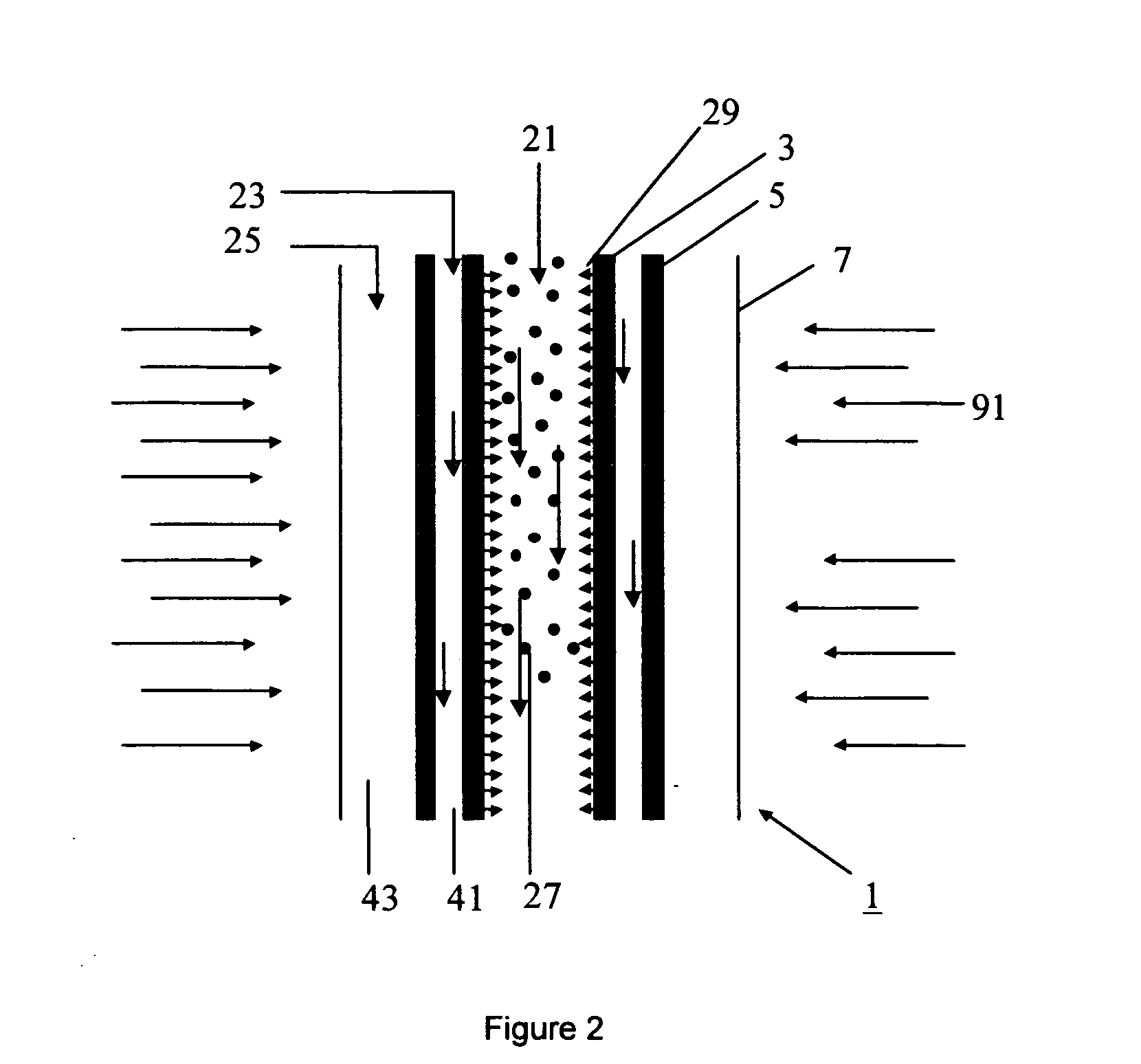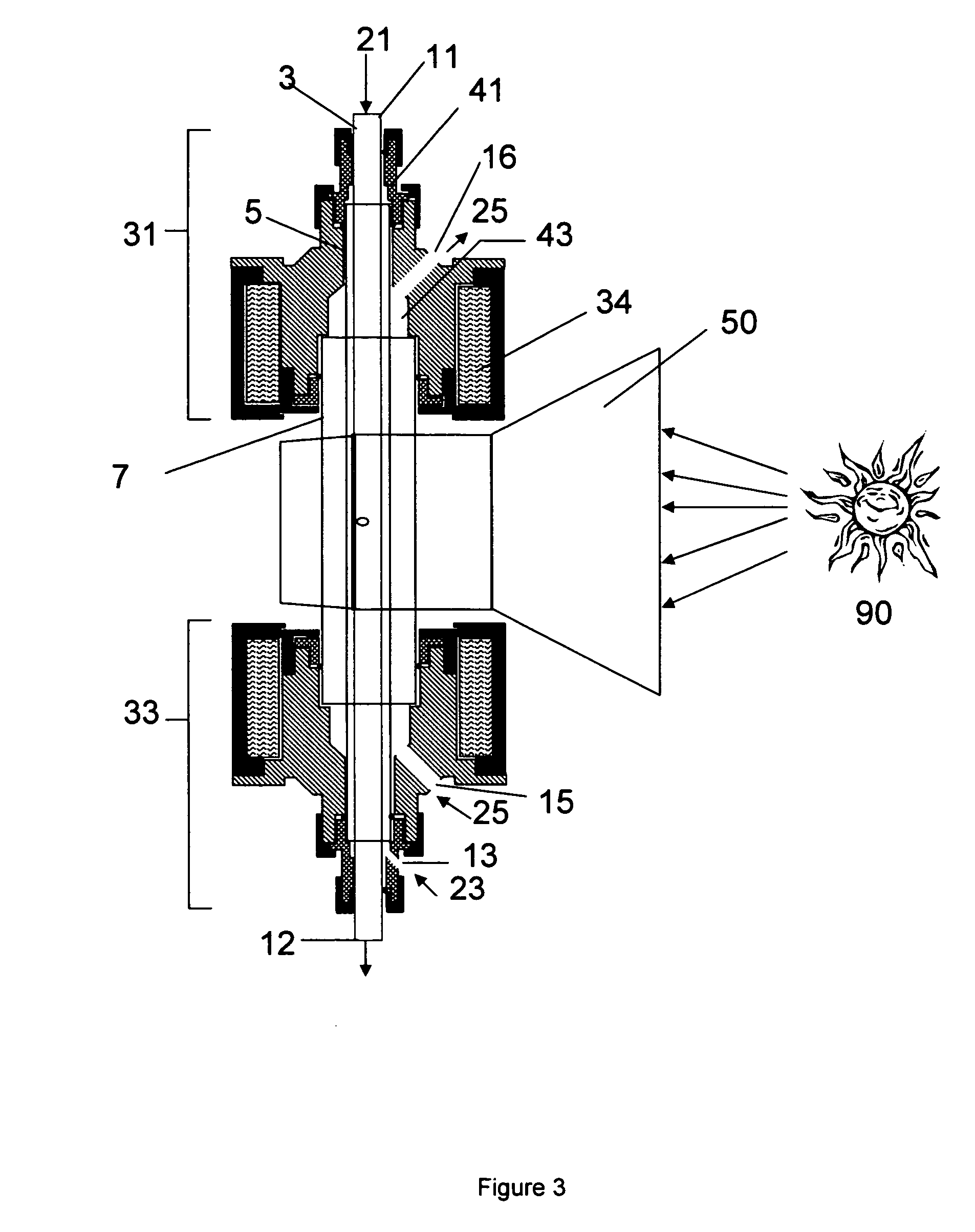Metal-oxide based process for the generation of hydrogen from water splitting utilizing a high temperature solar aerosol flow reactor
a solar thermal reactor and aerosol flow technology, applied in the direction of manganese oxide/hydroxide, chemistry apparatus and processes, chemical/physical/physico-chemical processes, etc., can solve the problems of not releasing the world from fossil fuel dependence, and reducing the efficiency of the maximum theoretical process, so as to reduce the recombination of oxygen, and limit the heterogeneous nucleation
- Summary
- Abstract
- Description
- Claims
- Application Information
AI Technical Summary
Benefits of technology
Problems solved by technology
Method used
Image
Examples
example 1
Simulations of the ZnO / Zn Cycle
[0123] The metal-oxide cycle that has been most researched in the technical literature is the ZnO / Zn cycle. As can be seen from FIG. 1, it has a ΔGf of zero at 2255 K, making it feasible for modern solar reactor systems [11]. If the Zn is fully recovered in the decomposition step, and ZnO fully recovered in the water splitting step, it is possible to make the only reaction input H2O and the only products O2 and H2, thus completing a renewable, sustainable cycle.
[0124] The ZnO decomposition reaction was simulated using the computer program FACT, and the equilibrium composition results of this simulation are shown in FIG. 9. As can be seen, FACT predicts the start of Zn vapor formation around 1800 K, with complete conversion occurring around 2150 K. At this point, only Zn, O2, and some elemental oxygen are formed. Due to the unstable nature of elemental oxygen, this will most likely form the diatomic gas when temperatures are reduced in the post-reacti...
example 2
Simulations of the Mn2O3 / MnO Cycle
[0126] Thermodynamic simulation of the decomposition step of this reaction (Eq. (6)) was conducted using the FACT software. The equilibrium composition results of this simulation can be seen in FIG. 11. From these equilibrium data, a few interesting and desirable qualities of this system come to light. First, complete decomposition to solid phase MnO and gaseous O2 occurs around 1800 K with an equimolar inert feed. This is at a lower temperature than required for the ZnO system, allowing for higher reactor efficiency due to lower reradiation losses. In addition, the separation of gaseous O2 from solid MnO upon cooling is straightforward.
[0127] Additional calculations also show that Mn2O3 reduction is feasible in an air atmosphere.
example 3
Demonstration of Production of Zn from ZnO at Moderate Residence Times in a Conventional Aerosol Flow Reactor
[0128] To demonstrate the efficacy of ZnO dissociation in high temperature aerosol flow, ZnO oxide (size approximately 900 nm-1 μm) particles were entrained in Argon gas and fed into a conventional aerosol flow reactor without a fluid wall. Conversions exceeding 20% were observed at moderate temperatures (1600° C.) and residence times (1.0 s). At higher temperatures, faster rates of Zn production were observed.
[0129] The product Zn particles had sizes ranging from 20 nm-400 nm. These small particles would likely be more reactive with water due to decreased mass and heat transfer limitations. The particles were collected on an HEPA filter and in a gravity collection vessel, and were well dispersed and non-agglomerated. The production of this Zn powder effectively demonstrates the concept of using an aerosol reactor for ZnO dissociation.
[0130] The cooling chamber consisted o...
PUM
| Property | Measurement | Unit |
|---|---|---|
| Temperature | aaaaa | aaaaa |
| Length | aaaaa | aaaaa |
| Melting point | aaaaa | aaaaa |
Abstract
Description
Claims
Application Information
 Login to View More
Login to View More - R&D
- Intellectual Property
- Life Sciences
- Materials
- Tech Scout
- Unparalleled Data Quality
- Higher Quality Content
- 60% Fewer Hallucinations
Browse by: Latest US Patents, China's latest patents, Technical Efficacy Thesaurus, Application Domain, Technology Topic, Popular Technical Reports.
© 2025 PatSnap. All rights reserved.Legal|Privacy policy|Modern Slavery Act Transparency Statement|Sitemap|About US| Contact US: help@patsnap.com



